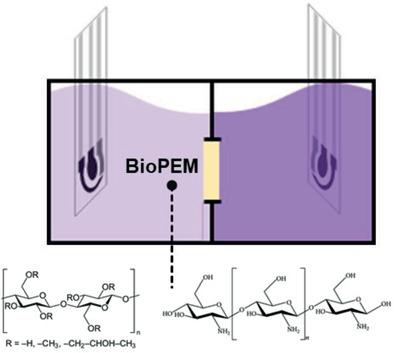当前位置:
X-MOL 学术
›
Adv. Sust. Syst.
›
论文详情
Our official English website, www.x-mol.net, welcomes your
feedback! (Note: you will need to create a separate account there.)
Biopolymer Electrolyte Membranes (BioPEMs) for Sustainable Primary Redox Batteries
Advanced Sustainable Systems ( IF 6.5 ) Pub Date : 2019-12-20 , DOI: 10.1002/adsu.201900110 Perla Patricia Alday 1 , Sandra Cerqueira Barros 2 , Raquel Alves 2 , José M. S. S. Esperança 3 , Marina Navarro‐Segarra 1 , Neus Sabaté 1, 4 , Maria Manuela Silva 2 , Juan Pablo Esquivel 1
Advanced Sustainable Systems ( IF 6.5 ) Pub Date : 2019-12-20 , DOI: 10.1002/adsu.201900110 Perla Patricia Alday 1 , Sandra Cerqueira Barros 2 , Raquel Alves 2 , José M. S. S. Esperança 3 , Marina Navarro‐Segarra 1 , Neus Sabaté 1, 4 , Maria Manuela Silva 2 , Juan Pablo Esquivel 1
Affiliation

|
The proliferation of portable electronic devices has resulted in an increase of e‐waste that is generated after their use. One of the most hazardous components in e‐waste are batteries, due to their content of heavy metals and toxic chemicals. Fuel cells and redox flow batteries have been recognized as more sustainable alternatives to Li‐based batteries for powering portable applications. Although they provide comparable energy and power densities, they still face some challenges because they rely on proton exchange membranes based on nonenvironmentally friendly, high‐priced perfluorosulfonic acid copolymers that require energy‐intense manufacturing and recycling procedures. In this work, eco‐friendly and sustainable biopolymer electrolyte membranes (BioPEMs) are synthesized from biopolymers like chitosan, cellulose, and starch. These BioPEMs bring forth advantages in performance, sustainability, and cost. Additionally, they present good chemical and mechanical stability, high ionic conductivity in the same order of magnitude as Nafion membranes. Two alternatives of cellulose–chitosan based BioPEMs are successfully applied into primary redox batteries using benign eco‐friendly redox chemistries, delivering open circuit voltages above 0.75 V and power output up to 2.5 mW cm−2. These results demonstrate BioPEMs capability to improve biodegradable batteries in sectors requiring a transient electrical energy, such as environmental monitoring, agriculture, or packaging.
中文翻译:

生物聚合物电解质膜(BioPEMs)用于可持续的一次氧化还原电池
便携式电子设备的激增导致使用后产生的电子垃圾增加。电子垃圾中最危险的成分之一是电池,因为它们含有重金属和有毒化学物质。燃料电池和氧化还原液流电池已被公认为是为便携式应用供电的锂基电池的更可持续的替代品。尽管它们提供可比的能量和功率密度,但它们仍面临一些挑战,因为它们依赖于质子交换膜,该膜基于非环境友好的,高价位的全氟磺酸共聚物,需要高强度的制造和回收程序。在这项工作中,从壳聚糖,纤维素和淀粉等生物聚合物中合成了环保,可持续的生物聚合物电解质膜(BioPEM)。这些BioPEM在性能,可持续性和成本方面都具有优势。此外,它们还具有良好的化学和机械稳定性,以及与Nafion膜相同数量级的高离子电导率。两种基于纤维素-壳聚糖的BioPEM替代品已通过使用良性环保氧化还原化学物质成功应用于一次氧化还原电池,可提供0.75 V以上的开路电压,输出功率高达2.5 mW cm−2。这些结果表明,BioPEMs在需要瞬态电能的领域(如环境监测,农业或包装业)改善生物可降解电池的能力。
更新日期:2020-02-07
中文翻译:

生物聚合物电解质膜(BioPEMs)用于可持续的一次氧化还原电池
便携式电子设备的激增导致使用后产生的电子垃圾增加。电子垃圾中最危险的成分之一是电池,因为它们含有重金属和有毒化学物质。燃料电池和氧化还原液流电池已被公认为是为便携式应用供电的锂基电池的更可持续的替代品。尽管它们提供可比的能量和功率密度,但它们仍面临一些挑战,因为它们依赖于质子交换膜,该膜基于非环境友好的,高价位的全氟磺酸共聚物,需要高强度的制造和回收程序。在这项工作中,从壳聚糖,纤维素和淀粉等生物聚合物中合成了环保,可持续的生物聚合物电解质膜(BioPEM)。这些BioPEM在性能,可持续性和成本方面都具有优势。此外,它们还具有良好的化学和机械稳定性,以及与Nafion膜相同数量级的高离子电导率。两种基于纤维素-壳聚糖的BioPEM替代品已通过使用良性环保氧化还原化学物质成功应用于一次氧化还原电池,可提供0.75 V以上的开路电压,输出功率高达2.5 mW cm−2。这些结果表明,BioPEMs在需要瞬态电能的领域(如环境监测,农业或包装业)改善生物可降解电池的能力。











































 京公网安备 11010802027423号
京公网安备 11010802027423号